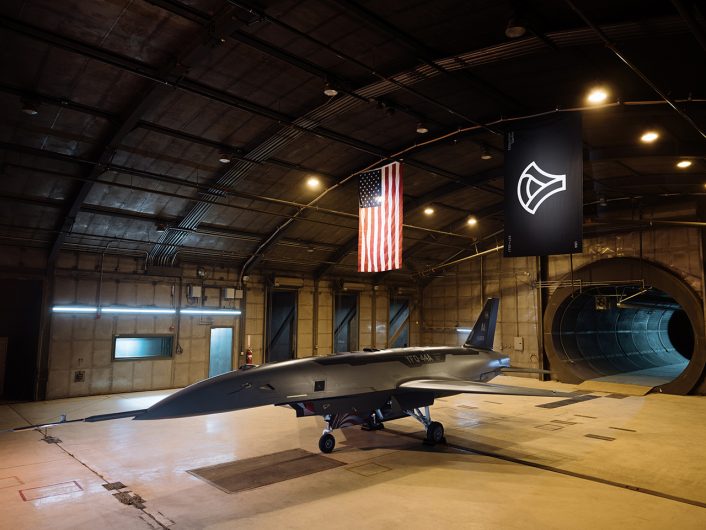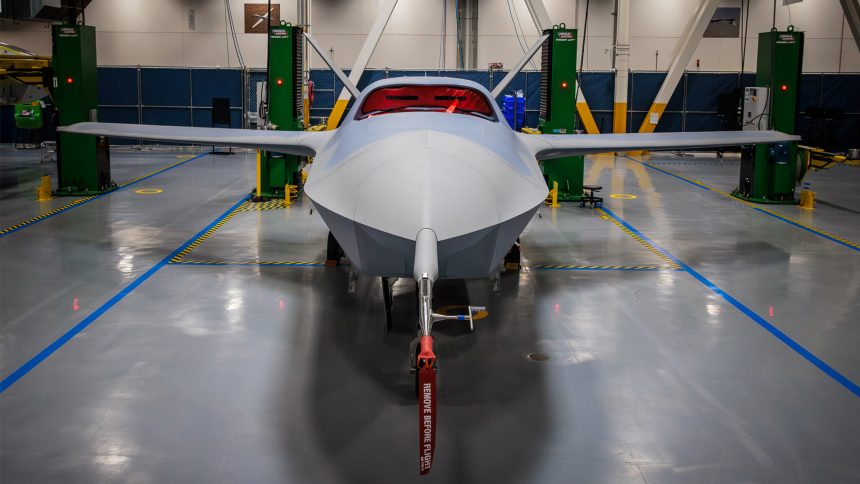For the first time, we now have an image of General Atomics’ YFQ-42A in the flesh. Alongside Anduril’s YFQ-44A, they will be the U.S. Air Force’s first uncrewed fighters.
General David Allvin, Chief of Staff of the U.S. Air Force, revealed the aircraft in a post on social media. He describes Collaborative Combat Aircraft (CCA), such as the YFQ-42A and the Anduril YFQ-44A, as “cost-effective” but “truly lethal” and labels them “uncrewed fighters”.
The overall design of the YFQ-42A was known to some degree, based on renderings and mockups, as well as the fact it is derived from the earlier XQ-67, which first flew in 2024. Compared to the XQ-67, the YFQ-42A features a more rounded engine air inlet as well as apparently slightly modified fuselage mould lines. These design changes might be the result of attempts to reduce the airframe’s radar cross-section to match stealth requirements of the CCA program.
Flight testing of the aircraft is, according to manufacturer General Atomics Aeronautical Systems Inc (GA-ASI), expected to commence within months. Anduril’s YFQ-44A ‘Fury’ is scheduled to follow a similar timeframe, having also been officially unveiled earlier this month.

The YFQ-44A, on the surface, appears with a more conventional planform compared to General Atomics’ offering, choosing a vertical tail and under-fuselage air intake. The YFQ-42A, by comparison, mirrors the XQ-67 by having its air inlet on the top-side of the fuselage, and twin canted tail surfaces more reminiscent of typical stealth fighter aircraft.
Based on a graphic released by Allvin last week, and assuming the data is accurate, the two Increment 1 CCAs will not match the Boeing F-47 or Lockheed Martin F-22 Raptor in terms of overall stealth, but will feature reduced radar cross-section measures roughly equivalent to the F-35. They will offer a combat radius in excess of 700 nautical miles, entering service between 2025 and 2029 and numbering over 1000 individual units. This reflects the CCA’s role as a more attritable, lower risk weapons platform or sensor picket that will operate alongside manned fighters and perform missions that would otherwise result in the loss of human crews.
How will Collaborative Combat Aircraft #CCA be affordably armed ?
USAF this past week issued an RFI seeking Low-Cost High-Speed Air-to-Air Missiles both similar in length to the AMRAAM (12 ft) & in the 6 ft #HALFRAAM form factor. USAF wants AUR cost <$250,000. pic.twitter.com/fPUj0cHAHn
— AirPower 2.0 (MIL_STD) (@AirPowerNEW1) May 4, 2025
“The YFQ-42A is an exciting next step for our company,” said GA-ASI President David R. Alexander. “It reflects many years of partnership with the U.S. Air Force of advancing unmanned combat aviation for the United States and its allies around the world, and we’re excited to begin ground testing and move to first flight.”
YFQ-42A is GA-ASI’s third jet-powered unmanned platform, after the XQ-67 as well as the internally funded MQ-20 Avenger or ‘Predator C’. The company is otherwise responsible for the class-leading MQ-9 Reaper and related developments like the MQ-9 Predator B or Protector RG1.
Further increments of the CCA program are expected to follow in due course, introducing more aircraft types into the mix. The requirements of Increment 2 are in the process of being finalized, but current leanings have suggested lower-cost and potentially smaller designs may be on the cards, though still with top-level capabilities.
Just because it’s called Inc 2 doesn’t mean it “has more capability…we’re still looking to figure out..the right balance..The AF may yet decide to “change the focus” of CCAs “from a missile truck to something else..https://t.co/OJKpbRcPRI
— AirPower 2.0 (MIL_STD) (@AirPowerNEW1) November 16, 2024
Lockheed Martin, who failed to be selected for Increment 1, believed that their proposal for the initial contract overshot the requirements by a significant degree and will tailor their Increment 2 submission accordingly. The company is leveraging its role as the lead manufacturer of the F-35 Lightning II and F-22 Raptor to tout bespoke integration of CCA technology into fifth generation fighters as well as sixth generation fighters.
Concepts released by the company depict CCAs more closely resembling the size and shape of cruise missiles, compared to the full-aircraft size YFQ-42 and YFQ-44. This could allow CCAs to be carried into combat themselves by other aircraft, including non-fighter platforms like the B-21 Raider which the U.S. Air Force is said to be interested in integrating with CCA operations.
Home Base
At the beginning of May, Beale Air Force Base in California, home of the U-2, was selected as the preferred initial host station for these CCAs. The exact timelines for establishing operational units remain classified, though, if the recently released graphic is correct, they will likely appear over the coming few years. Beale AFB is still yet to be subject to more formal impact assessments which will determine whether the base is suitable, or if an alternative location must be chosen.
The nature of CCAs means that no matter where their physical home station is, they will be transported across the road to different forward operating locations as required. As such, actual flight operations of the aircraft types from whichever base is eventually finalized are likely to be less regular than would be expected for manned types.









